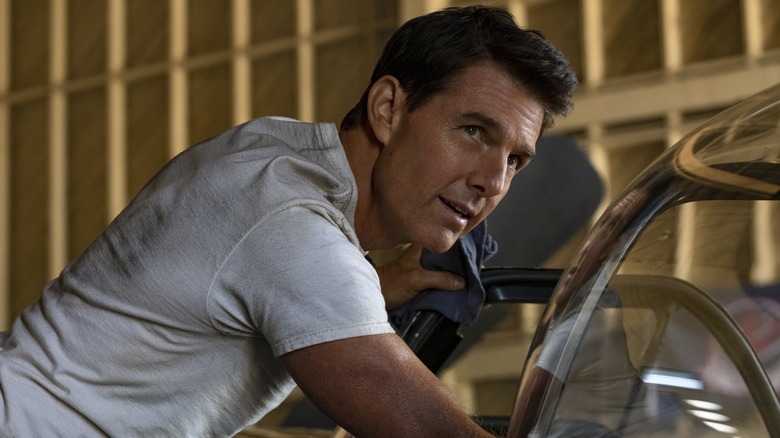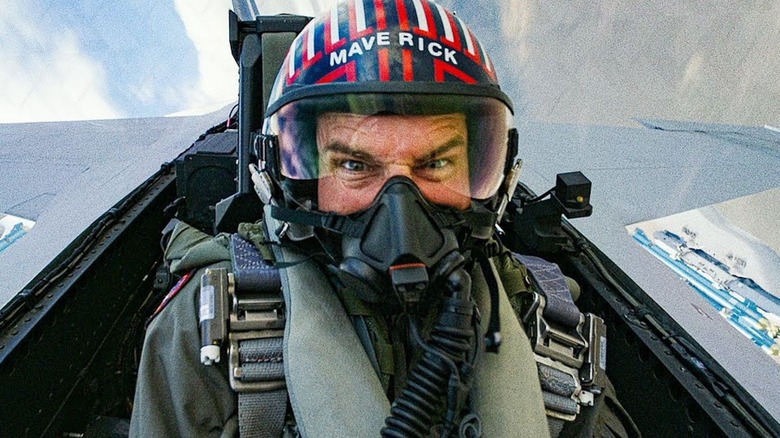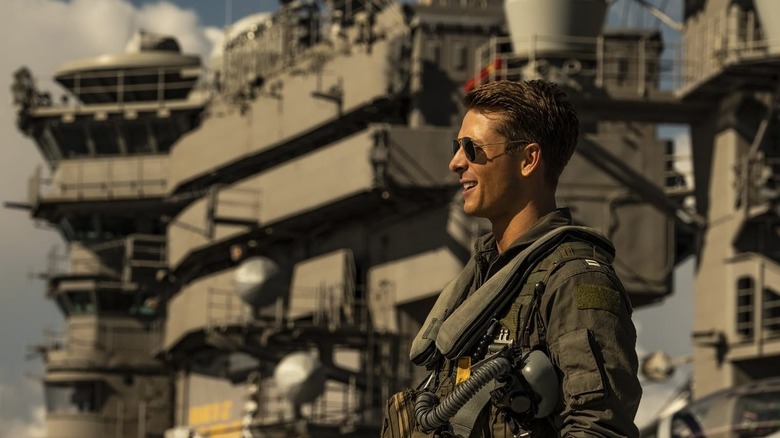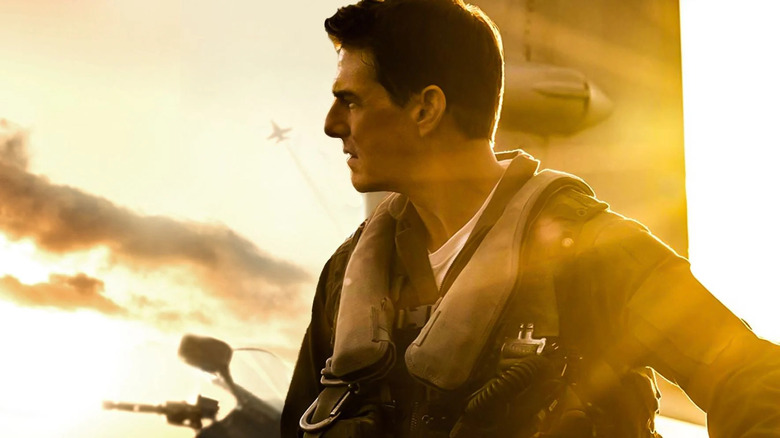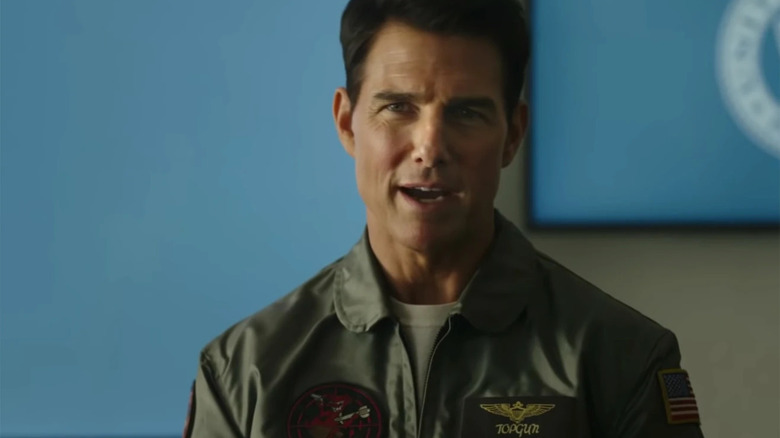Top Gun: Maverick Ending Explained: The Need For Speed (And Redemption)
Spoiler warning: This article will openly discuss the plot and the ending of "Top Gun: Maverick"
In Joseph Kosinski's "Top Gun: Maverick," Tom Cruise plays Pete Mitchell, a Navy jet pilot who is still doing the same things at age 59 as he was doing at age 24. Namely: He's flying planes very quickly, wearing a very particular leather jacket and aviator shades (fair play for an aviator), and zipping around various military installations on his vintage motorcycle. The motorcycle wasn't vintage when he started riding it. Pete spends most of his days flexing, working on machines, smiling dazzlingly to himself, and living up to his (self-appointed?) nickname of Maverick. Maverick is less a human being as a distant collection of 1980s movie clichés, which is fitting, given Cruise codified the "Maverick" character type in Tony Scott's 1986 blockbuster/clunker "Top Gun." Since then, Cruise has made a career of showing off how inhuman and un-aging he is.
"Maverick" covers many of the same plot and character beats as the 1986 original: A team of hotshot pilots, each of them playfully rebellious (but not so rebellious as to be ejected from the Navy), indistinguishable from parodies of themselves, must perform a very difficult jet attack that needs to be accomplished on a specific time frame. In the case of "Maverick," Pete Mitchell now serves as the hotshots' teacher, naturally demanding the near-impossible: Be as fecklessly cool as Tom Cruise in "Top Gun." Few are equal to the task.
The Star Wars mission
After an opening act of introductory material (Maverick is the same character, there are some new hotshots, one of them is Rooster, played by Miles Teller, the son of Anthony Edwards' character from the 1986 film), the audience is informed that someone — someone — has their hands on some nuclear material hidden in a bowl-shaped mountain bunker somewhere in the world. It's never specified in what country the bunker is located (it's snowy and can be accessed by aircraft carrier) or what nation stole the nuclear materials. The soldiers only know they have been ordered to fire missiles at it. Their mission will be a parallel of "Star Wars," wherein the pilots have to fly down a very narrow valley, mere feet off the ground, to avoid radar detection. They will then have to fly over a mountain ridge and down into a crater where the bunker is located. One team of planes will blow open the crater, and a second team immediately behind them will shoot a missile down inside of it. To escape, the pilots will have to fly out of the crater over a very tall mountain, risking blackouts because of the g-forces, and avoiding enemy missiles. With the Nintendo mission in place, training can begin.
The unchanging Maverick
The arc of Pete Mitchell is still, as it was in the original, a flatline. There aren't a lot of lessons he needs to learn, nor changes he needs to make. Maverick stepped into the world fully formed, and it's up to the world to match his intensity. Watching such a character can be exhilarating; Maverick may serve as an aspirational character for 8-year-olds who need unflappability lessons. And indeed, others come around: By the end of "Top Gun," his former rival Iceman (Val Kilmer, who returns for "Maverick") becomes his friend (and perhaps lover, although that's not fully explored). He loses a compatriot, but it wasn't so much Maverick's attitude or recklessness that killed him as the vague indignities of an unnamed war.
Kosinski's "Maverick" presented an opportunity for the title character to — perhaps — change. It's 2022, Ronald Reagan is no longer in office, and the public's attitudes about war have carried through quagmires in Iraq and Afghanistan. Gung-ho fantasies about fast jets and missiles may not have the same implications as they did in 1986. It's high time to reconsider Maverick. It's time for him to lose something, to sacrifice something for the greater good, to look inward and ask if his lifetime of being ultra-cool and endlessly capable has gotten him anything.
But who am I kidding? One doesn't watch a long-in-the-tooth "Top Gun" sequel hoping that its unchanging, inhuman hero will change ... unless we look at the ending in the right light.
Andy Klein's theory of 'War of the Worlds'
Film critic Andy Klein once wrote a brilliant review of the 2005 Steven Spielberg sci-fi disaster movie "War of the Worlds," also starring Cruise. The review is, sadly, no longer online, but in it, Klein posited that there were in fact no aliens in the movie and that Cruise's character — a bad divorced dad who his kids hate — was actually having an elaborate rescue fantasy wherein he would be permitted to be the hero in his kids' lives. With the world falling apart, Cruise finally gets to step up and re-earn his family's affection. Klein's theory certainly makes sense, given "Worlds'" treacly family reunion ending.
The end of "Maverick" has a similar read. The pilots in question enact the mission described, more or less without a hitch. During the daring escape, however, the character of Rooster (Miles Teller) is spared from enemy fire by Maverick's hotdogging midair maneuvers. Maverick's plane is shot down, and Maverick presumably dies. At best, he'll be stranded behind enemy lines in the country of [cough, cough, speech trails off]. Maverick sacrificed his life to save the son of a fallen comrade and finally lost something in the process: His own life. This is the perfect ending for Maverick's story. He considered someone else to be more important than himself for a brief moment. Rooster and his friends will fly back home, pleased that the mission was complete, saddened at the death of their teacher, but inspired by his sacrifice. And Maverick, who has long felt guilty for the death of Goose, is redeemed by saving Goose's son Rooster by sacrificing his own life.
Soon, the wolves will appear
But of course, Maverick can't die. Instead, there's a big climax in which Rooster returns, saves Maverick, and the two of them back to the aircraft carrier together. If you want, feel free to think of it as a fantasy sequence. The remainder of "Top Gun: Maverick" could very well be the end-of-life mental throes of a dying Maverick as he freezes to death, broken and bleeding, in the woods. He imagines the following events: Rooster, in defiance of orders, returns to Maverick's crash site, bailing out merely to check on him. Maverick is unbroken, unbruised, actually in a pretty good mood. Old guy's still got it.
But how will the two now return to base? As chance would have it, the Enemy has a small, protected hangar with a 1986-era jet hidden inside of it. Maverick and Rooster hijack the jet, perform a daring, short-runway takeoff, and fight their way through the attacks of enemy jets to make it to freedom. It's a good thing an old guy who knows about old jets was there. His know-how saved you young whippersnappers. Maverick walks away from the drama, still unflappable, still unchanged, having inspired those around him to come to his rescue and assure his cool will live forever as he races around with his newest girlfriend, bartender Penny (Jennifer Connelly). Generation X will never die, and Maverick is here to prove it. Let's listen to some hair metal and ponder joining the Navy. These would indeed be the final thoughts of a dying Maverick as he bleeds into the snow, his legs far from the rest of his body. Soon, the wolves will stalk out of the woods. Death is coming, Maverick. However cool you are, death comes for us all.
"Top Gun: Maverick," in the spirit of the 1986 original, is slick, awesome, exciting, and completely empty. It's on track to become an enormous hit, just as the original was. And, with the right kind of eyes, features a fitting death for a heroic icon. Or it just gives Maverick another happy ending. Whichever works for you.
